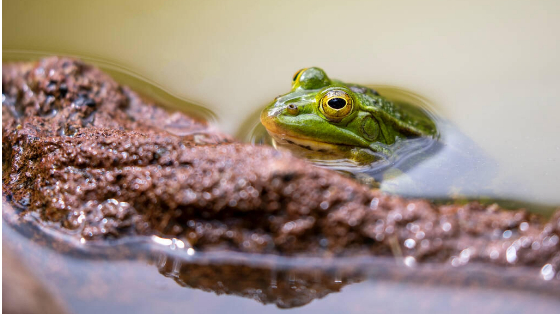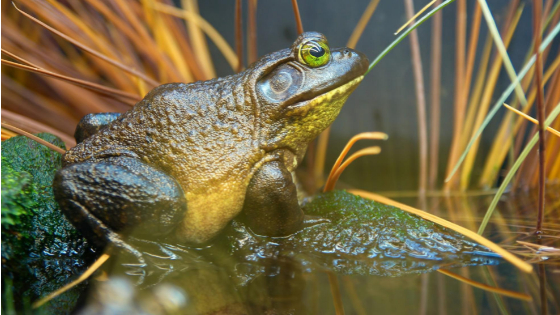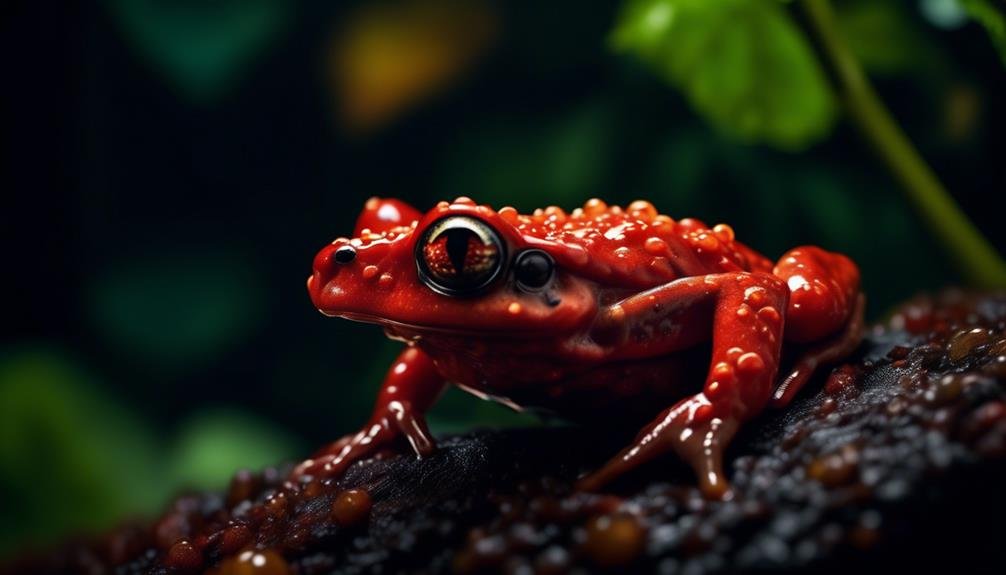
The tomato frog, a captivating amphibian endemic to Madagascar, possesses a secret defense mechanism that is nothing short of astonishing. While its vibrant red coloration may catch the eye, it is the frog’s ability to ward off threats that truly sets it apart.
When faced with danger, the tomato frog employs a unique tactic – it inflates its body and secretes a thick substance that numbs the eyes and mouth of predators. This intriguing behavior not only showcases the frog’s remarkable adaptability, but also raises questions about the evolution of such a terrifying defense mechanism.
How did the tomato frog acquire this extraordinary ability? And what other secrets might this fascinating creature hold? The answers lie within the depths of its captivating nature, waiting to be unraveled.
Key Takeaways
- Tomato frogs have a bright red color and can puff up their bodies when threatened.
- The frog’s skin secretes a thick substance that numbs predators’ eyes and mouth.
- Tomato frogs have a lifespan of 6 to 8 years and can vary in color from yellowish orange to deep red.
- Females are larger than males and can reach 4 inches in length.
Tomato Frog’s Unique Adaptation
The tomato frog’s unique defense mechanism sets it apart from other amphibians. When threatened, tomato frogs have the ability to puff up their bodies, making themselves larger and more intimidating.
However, what truly sets them apart is the secretion of a thick, toxic substance from their skin. This substance, when coming into contact with a predator’s eyes or mouth, causes numbness and discomfort, forcing the predator to release the frog.
This defense mechanism is highly effective in deterring potential threats and ensuring the survival of the tomato frog. It is a remarkable adaptation that showcases the ingenuity of nature in providing organisms with the tools they need to protect themselves.
The tomato frog’s ability to produce and utilize this toxic secretion is truly remarkable and sets it apart from other amphibians.
The Terrifying Power of Puffing Up
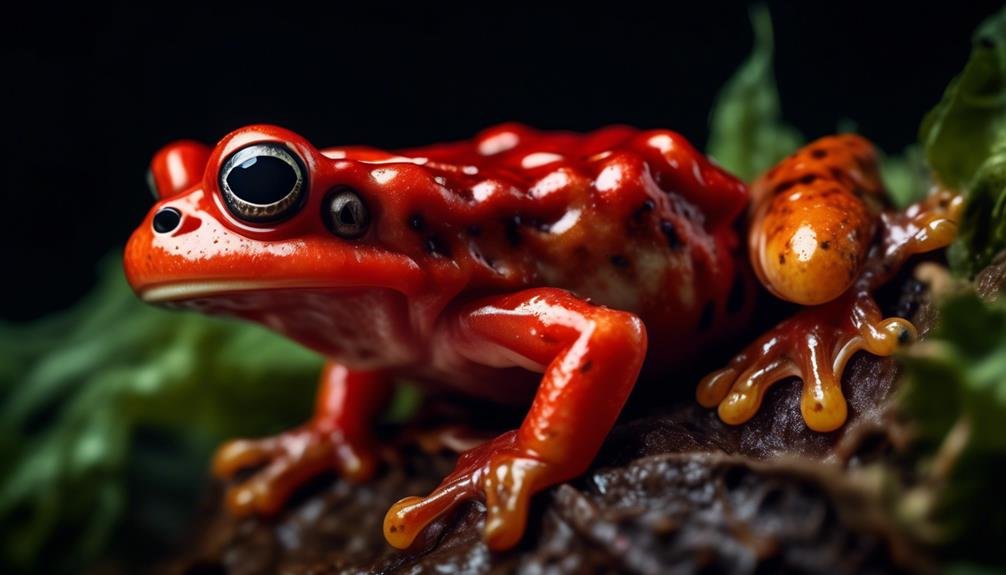
When threatened, tomato frogs have the remarkable ability to puff up their bodies, a defense mechanism that serves to intimidate predators and ensure their survival. This unique adaptation is a powerful tool that tomato frogs use to ward off potential threats.
Here are four fascinating facts about the terrifying power of puffing up:
- Increased Size: By inflating their bodies, tomato frogs appear larger and more intimidating to predators. This sudden change in size can startle and deter potential attackers.
- Visual Intimidation: Puffing up also enhances the frog’s visual appearance. The bright red coloration of tomato frogs becomes even more pronounced, signaling danger to predators and warning them to stay away.
- Physical Barrier: When a tomato frog puffs up, its skin becomes stretched and tight, forming a protective barrier against predators. This makes it more difficult for predators to grab or swallow the frog.
- Chemical Defense: Puffing up also triggers the release of a thick, noxious secretion from the frog’s skin. This substance is toxic and can cause discomfort or pain to predators, discouraging them from pursuing the frog further.
The Secret Weapon: Numbing Secretion
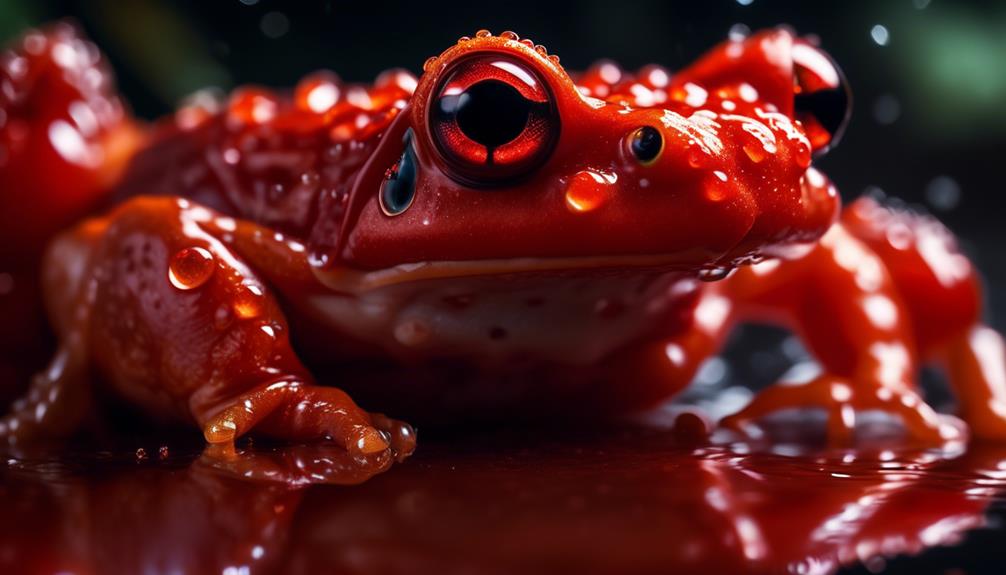
After employing their remarkable ability to puff up their bodies, tomato frogs unveil their secret defense mechanism: a numbing secretion that serves as their secret weapon against predators. When threatened, tomato frogs secrete a thick substance from their skin that contains chemicals capable of numbing predators’ eyes and mouth. This unique adaptation allows the frogs to escape from the grasp of their attackers, as the numbing effect causes predators to release the frog. The secretion acts as a powerful deterrent, making potential predators think twice before attempting to prey on these brightly colored amphibians. This numbing secretion is just one of the many fascinating features that make tomato frogs such formidable creatures in the animal kingdom.
| Secret Weapon: Numbing Secretion |
|---|
| – Thick secretion from the frog’s skin |
| – Contains chemicals that numb predators’ eyes and mouth |
| – Acts as a powerful deterrent |
| – Allows the frog to escape from predators |
| – Contributes to the frog’s survival and defense against threats |
Tomato Frog’s Colorful Transformation
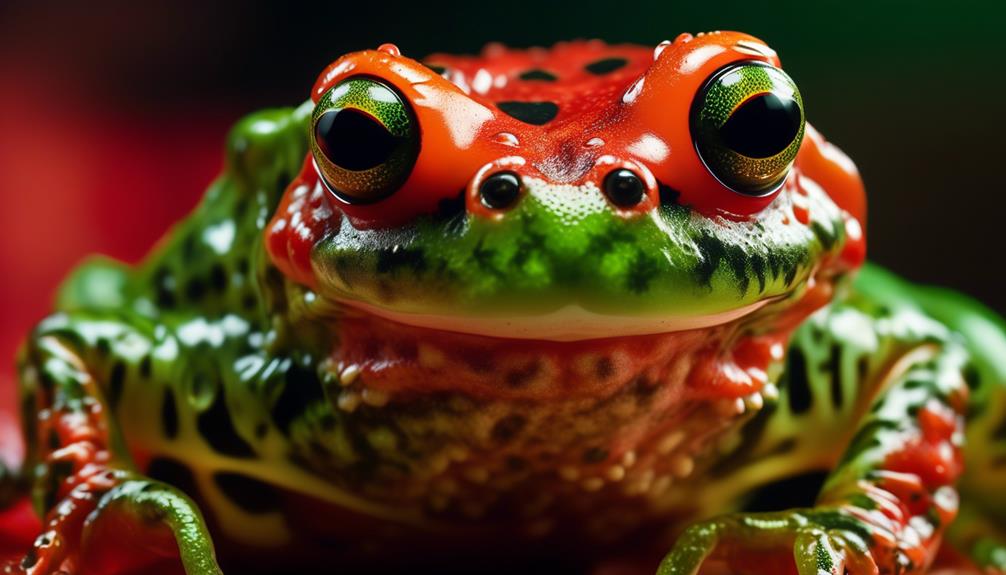
Exhibiting a remarkable display of adaptation, tomato frogs undergo a captivating and colorful transformation as they mature. This transformation is not only visually stunning but also serves important purposes in their survival. Here are four fascinating aspects of the tomato frog’s colorful transformation:
- Juvenile to adult: When tomato frogs are young, they have a dull coloration that helps them blend in with their surroundings, providing camouflage from potential predators. However, as they mature, their vibrant colors begin to develop, making them more visible to potential mates.
- Mating season: The bright colors of adult tomato frogs play a crucial role in attracting mates during the breeding season. Males display their colorful transformation to impress females and establish dominance in their territory.
- Warning signal: The vivid red or orange coloration of tomato frogs serves as a warning signal to potential predators. It signals that the frog is toxic, containing harmful chemicals in its skin, and should not be consumed.
- Intimidation: The striking colors of tomato frogs, combined with their ability to puff up their bodies, create a visually intimidating display. This transformation acts as a deterrent to predators, making them think twice before attacking.
Through their vibrant transformation, tomato frogs not only enhance their chances of reproduction but also protect themselves from potential threats in their environment.
A Closer Look at Tomato Frog’s Defense
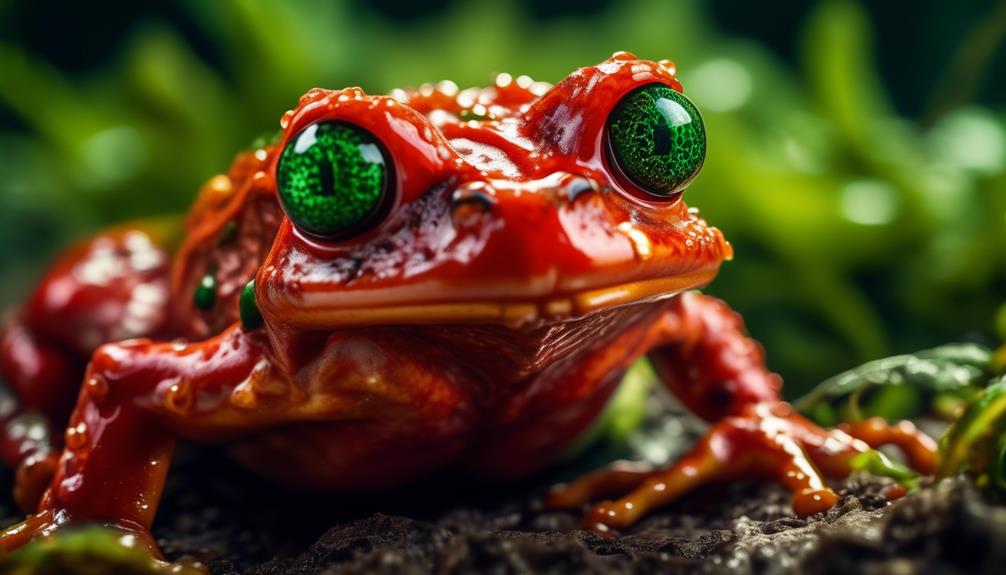
The defense mechanism of the tomato frog is a fascinating adaptation that ensures its survival in the face of potential threats. When threatened, the frog’s unique defense mechanism kicks in, allowing it to protect itself from predators. The frog’s skin secretes a thick substance that numbs the eyes and mouth of predators, causing them to release the frog. This defense mechanism is highly effective in deterring predators and allowing the tomato frog to escape unharmed. To further illustrate the effectiveness of this defense mechanism, here is a table highlighting the key features of the tomato frog’s defense:
| Key Features of Tomato Frog’s Defense |
|---|
| Skin secretion numbs predators’ eyes and mouth |
| Deters predators from attacking |
| Allows tomato frog to escape unharmed |
Through this table, it becomes evident that the tomato frog’s defense mechanism is a crucial adaptation that ensures its survival in its natural habitat.
Frequently Asked Questions
What Is the Lifespan of a Tomato Frog?
The lifespan of a tomato frog is typically 6 to 8 years. These frogs, found only in Madagascar, have a unique bright red color and can grow up to 4 inches in length.
How Do Tomato Frogs Defend Themselves When Threatened?
Tomato frogs defend themselves by puffing up their bodies and secreting a thick substance from their skin. This substance numbs predators’ eyes and mouth, causing them to release the frog.
What Is the Size Difference Between Male and Female Tomato Frogs?
The size difference between male and female tomato frogs is significant, with females reaching a length of 4 inches, while males typically grow to 2 to 3 inches in length. This disparity is a common characteristic in this species.
When Is the Reproductive Activity of Tomato Frogs Highest and Lowest?
The reproductive activity of tomato frogs is highest from January to May and lowest from June to December. During these periods, they lay fresh eggs monthly, except for November. This information was studied in an urban pond on Madagascar’s east coast.
How Often Do Tomato Frogs Lay Eggs and Is There a Specific Month When They Do Not Lay Eggs?
Tomato frogs lay fresh eggs every month except for November. The reproductive activity of tomato frogs is highest from January to May, and lowest from June to December.
What Other Defense Mechanisms Do Tomato Frogs Have Apart from their Terrifying Aspect?
Tomato frogs have adapted to their environment with camouflage and toxins, but they also possess another defense mechanism. They secrete a substance that acts as a deterrent against predators. This ability to produce such a substance is similar to the miraculous medicinal asiatic toad, which also uses defensive secretions to protect itself in the wild.
Conclusion
In conclusion, the tomato frog’s unique defense mechanism of inflating its body and secreting a numbing substance showcases its ability to protect itself in its natural habitat.
Its vibrant red coloration, size variations, and color transformation throughout its lifespan further add to its captivating nature.
While classified as least concern in terms of conservation status, the tomato frog’s fascinating traits and behaviors continue to intrigue researchers and enthusiasts alike.


